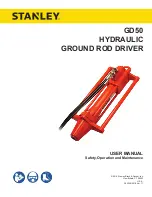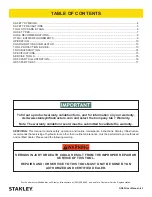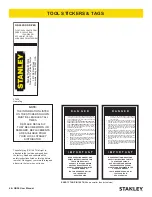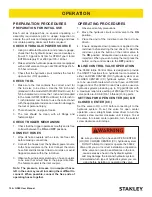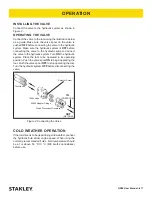
GD50 User
Manual ◄ 5
Tool operators and maintenance personnel must always
comply with the safety precautions given in this manual
and on the stickers and tags attached to the tool and
hose.
These precautions are given for your safety. Review
them carefully before operating the tool and before
performing general maintenance or repairs.
Supervising personnel should develop additional
precautions relating to the specific work area and local
safety regulations. Place the added precautions in the
space provided.
The GD50 Hydraulic Rod Driver will provide safe and
dependable service if operated in accordance with the
instructions given in this manual. Read and understand
this manual and any stickers and tags attached to the
tool and hoses before operation. Failure to do so could
result in personal injury or equipment damage.
•
Operator must start in a work area without
bystanders. The operator must be familiar with all
prohibited work areas such as excessive slopes and
dangerous terrain conditions.
• Establish a training program for all operators to
ensure safe operation.
•
Do not operate the tool unless thoroughly trained or
under the supervision of an instructor.
•
Always wear safety equipment such as goggles, ear
and head protection, and safety shoes at all times
when operating the tool.
•
Do not inspect or clean the tool while the hydraulic
power source is connected. Accidental engagement
of the tool can cause serious injury.
•
Always connect hoses to the tool hose couplers
before energizing the hydraulic power source. Be
sure all hose connections are tight.
•
Do not operate the tool at oil temperatures above
140 °F/60 °C. High temperatures can cause operator
discomfort.
•
Do not operate a damaged, improperly adjusted or
incompletely assembled rod driver.
•
Do not weld, cut with an acetylene torch or hardface
the rod driver anvil or guide housing.
•
To avoid personal injury or equipment damage,
all tool repair, maintenance and service must only
be performed by authorized and properly trained
personnel.
•
Always replace parts with replacement parts
recommended by STANLEY.
•
Check fastener tightness often and before each use
daily.
•
WARNING:
Some dust created by power sanding,
sawing, grinding, drilling, and other construction
activities contains chemicals known to the State
of California to cause cancer, birth defects or
other reproductive harm. Some examples of these
chemicals are:
•
Lead from lead-based paints,
•
crystalline silica from bricks and cement
and other masonry products, and
•
arsenic and chromium from chemically-
treated lumber.
Your risk from these exposures varies, depending
on how often you do this type of work. To reduce
your exposure to these chemicals: work in a well
ventilated area, and work with approved safety
equipment, such as those dust masks that are
specially designed to filter out microscopic particles.
Protect yourself and those around you. Research
and understand the materials you are cutting.
Follow correct safety procedures and comply with
all applicable national, state or provisional health
and safety regulations relating to them, including,
if appropriate arranging for the safe disposal of the
materials by a qualified person.
SAFETY PRECAUTIONS

